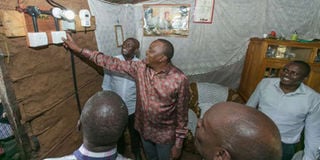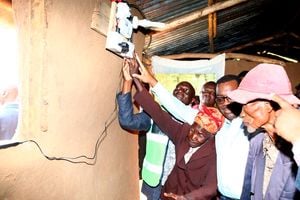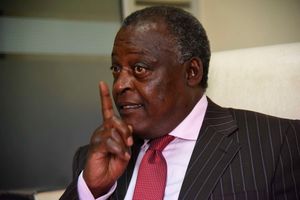
Former President Uhuru Kenyatta switches on the power in a house belonging to a beneficiary of the Last Mile Connectivity project.
At 76.5 per cent, Kenya has the fourth-highest electricity access rate in sub-Saharan Africa, according to the World Bank, making it one of the major achievements of the Jubilee government of former President Uhuru Kenyatta.
Kenya is beaten only by Ghana, Eswatini and Gabon, although its ranking drops when the much smaller island nations of Cabo Verde, Seychelles, Mauritius and Comoros, which have the highest rates in the region, are included.
This sounds like a miracle when you consider that only 29 per cent of Kenya's population had access to electricity in 2012.
Kenya's race to achieve universal electricity access by 2030 is being driven by the Last Mile Connectivity Programme (LMCP), launched by the Jubilee government in 2013.
The first three phases of the programme, funded by the Kenyan government, the African Development Bank (AfDB) and the World Bank, connected more than 1 million customers.
Last Mile sought to maximise the use of 35,000 existing distribution transformers spread across the country's 47 counties.
The transformers were maximised by extending the low voltage network to reach approximately 1.2 million people in the vicinity of these transformers.
A major success of the phased project was the relatively low cost, with customers paying a subsidised price of Sh15,000 to be connected.
Last Mile lit up rural villages, remote schools and hospitals, revolutionising the lives of millions.
However, a downside of the programme was that the rapid expansion of the grid by connecting millions of new customers in a short period of time, without upgrading the underlying infrastructure such as transmission lines, overwhelmed the grid.
Dr Joseph Siror, Managing Director of Kenya Power, says the government prioritised access to electricity in implementing the programme, which had a negative impact on reliability.
"When the government decided to expand rapidly and do the last mile to bring electricity to as many people as possible, that was the risk," Dr Siror said in an interview with the Nation.
"The government's rationale was that it would rather provide electricity to as many people as possible, even if there might be a few blackouts, than to provide electricity to (only) three million and ensure that those three million would never experience a blackout," he said.
Regardless, the process of connecting more customers to the grid continues to gather pace as Kenya races to achieve universal access to electricity within the next six years.
In the period to June 2023, for example, Kenya Power connected an additional 318,217 new customers to the grid, bringing the number of Kenyans now connected to electricity to 9,212,754.
The company said these new customers helped it sell an additional 99.98 gigawatt hours (GWh).
"The new connections were achieved through company-led electrification programmes complemented by contributions from the Last Mile Connectivity Project (LMCP), Rural Electrification and Renewable Energy Corporation (Rerec)-led connectivity programmes and government-funded programmes," the utility said.
Last year, Kenya Power launched the fourth phase of the last mile project, which involves the installation of 940 new transformers, optimisation of existing transformers and construction of power lines in the targeted counties.
The phase will provide electricity to approximately 280,473 households in 32 counties.
Last year, the utility said it had raised $180 million (Sh26.19 billion) from three multilateral lenders to finance the phase.
These included a Sh13.09 billion (€90 million) loan from the French Development Agency (AFD), a Sh436 billion (€30 million) grant from the European Union (EU) and a further Sh8.73 billion (€60 million) loan from the European Investment Bank (EIB).









